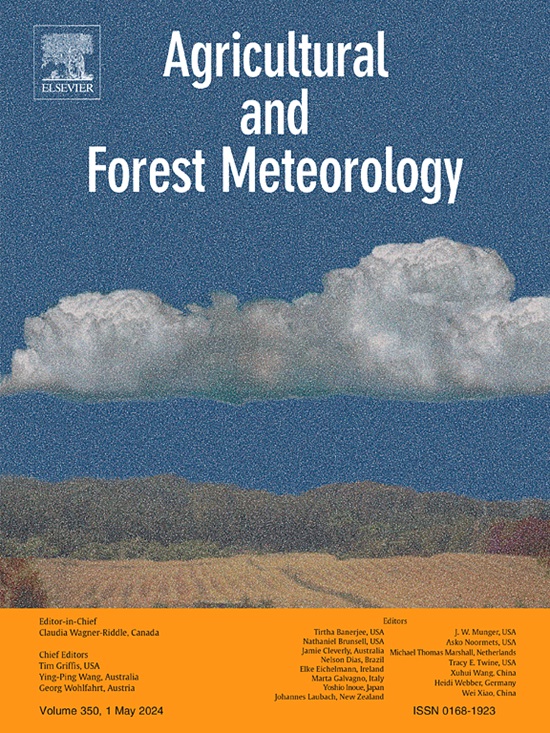后扩散CO2外排的同位素不平衡影响光合作用的C18OO辨别和叶肉电导的估计
IF 5.6
1区 农林科学
Q1 AGRONOMY
引用次数: 0
摘要
光合作用C18OO分馏(Δ18O)已被用于估算C3和C4物种的叶肉传导(gm)。然而,这需要了解叶片水分与穿透叶片内部并在不被同化的情况下重新逸出的CO2分子之间的同位素平衡程度(θr) (Fretro)。本文重新研究了Δ18O-gm估算理论及其对6种C3植物幼叶和老叶CO2 δ18O变化的敏感性。结果表明,在完全同位素平衡条件下,CO2源的δ18O对gm值较为敏感。利用一种区分代谢(Rt)和纯粹扩散(Fretro) CO2通量的新同位素质量平衡模型,我们发现总h2o平衡通量(θrFretro+Rt)代表净CO2同化的157±12%(平均±SE),并且与气孔导度呈正相关,表明气孔施加了限制。此外,叶水与Fretro (θ<1)或水化部位的CO2池(θ<1)没有完全平衡,这导致估计的gm存在误差。我们的结果对从叶肉电导角度解释Δ18O具有广泛的意义,并强调了考虑反向扩散CO2外排同位素不平衡的必要性。本文章由计算机程序翻译,如有差异,请以英文原文为准。
Isotopic disequilibrium of the retro-diffusive CO2 efflux affects photosynthetic C18OO discrimination and the estimation of mesophyll conductance
Photosynthetic C18OO fractionation (Δ18O) has been used to estimate mesophyll conductance (gm) in C3 and C4 species. However, this requires knowledge of the degree of isotopic equilibration (θr) between leaf water and the CO2 molecules penetrating the leaf interior and re-escaping without being assimilated (Fretro). Here, we re-examine the theory of Δ18O-gm estimation and its sensitivity to changes in the 18O composition (δ18O) of CO2 on young and old leaves of six C3 species. Our results showed that, when full isotopic equilibrium was assumed, gm values were sensitive to the δ18O of the CO2 sources. Utilizing a new isotopic mass balance model that distinguishes metabolic (Rt) and purely diffusive (Fretro) CO2 fluxes, we found that the gross H2O-equilibrated efflux (θrFretro+Rt) represented 157±12 % (mean±SE) of net CO2 assimilation, and was positively correlated to stomatal conductance, implying a limitation imposed by stomata. Furthermore, leaf water was not completely in equilibrium with Fretro (θr<1) or the CO2 pool at the site of hydration (θ<1), which led to errors in estimated gm. Our results have broad implications for the interpretation of Δ18O in terms of mesophyll conductance, and highlight the necessity of considering the isotopic disequilibrium of the retro-diffusive CO2 efflux.
求助全文
通过发布文献求助,成功后即可免费获取论文全文。
去求助
来源期刊
CiteScore
10.30
自引率
9.70%
发文量
415
审稿时长
69 days
期刊介绍:
Agricultural and Forest Meteorology is an international journal for the publication of original articles and reviews on the inter-relationship between meteorology, agriculture, forestry, and natural ecosystems. Emphasis is on basic and applied scientific research relevant to practical problems in the field of plant and soil sciences, ecology and biogeochemistry as affected by weather as well as climate variability and change. Theoretical models should be tested against experimental data. Articles must appeal to an international audience. Special issues devoted to single topics are also published.
Typical topics include canopy micrometeorology (e.g. canopy radiation transfer, turbulence near the ground, evapotranspiration, energy balance, fluxes of trace gases), micrometeorological instrumentation (e.g., sensors for trace gases, flux measurement instruments, radiation measurement techniques), aerobiology (e.g. the dispersion of pollen, spores, insects and pesticides), biometeorology (e.g. the effect of weather and climate on plant distribution, crop yield, water-use efficiency, and plant phenology), forest-fire/weather interactions, and feedbacks from vegetation to weather and the climate system.

 求助内容:
求助内容: 应助结果提醒方式:
应助结果提醒方式:


